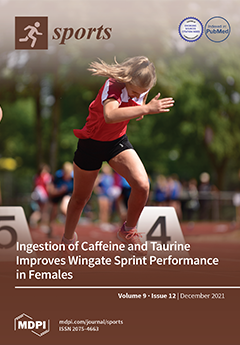The purpose of this study was to assess the acute effect of Accentuated Eccentric Loading (AEL) on countermovement jump (CMJ) height, peak power output (PPO) and peak velocity in male professional footballers using loads of 20% or 40% of body mass (AEL20 or AEL40, respectively). Twenty-three male professional football players (age 24 ± 4.5 years, range 18–34 years; body mass 80.21 ± 8.4 kg; height 178.26 ± 7.62 cm) took part in a randomised, cross-over design to test the potentiating responses of two AEL conditions (AEL20 and AEL40) versus a body weight control group (CON). Mean loads for the two conditions were 15.84 ± 1.70 kg (AEL20) and 31.67 ± 3.40 kg (AEL40). There was no significant difference between the three conditions for jump height (
p = 0.507, η
2G = 0.022). There were significant differences in peak power between the groups (
p = 0.001, η
2G = 0.154). Post hoc analysis with Bonferroni adjustment showed significantly higher peak power for both AEL conditions compared to the control group, but no significant differences between AEL conditions (CON vs. AEL20,
p = 0.029, 95% CI −1016.735, −41.815, Cohen’s
d = −0.56; CON vs. AEL40,
p = 0.001, 95% CI −1244.995, −270.075, Cohen’s
d = −0.81; AEL20 vs. AEL40,
p = 0.75, 95% CI −715.720, 259.201, Cohen’s
d = −0.24). There was no significant difference between the three conditions for peak velocity (
p = 0.269, η
2G = 0.046). AEL using either 20% or 40% of body mass may be used to increase peak power in the countermovement jump in well-trained professional football players.
Full article






